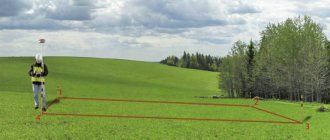Land, as an object of property, can be the cause of contradictions. The most common of them is a dispute with neighbors about the boundaries of a land plot. In practice, such situations arise quite often, especially if the boundaries of the allotment are not properly defined or their determination on the ground is somehow complicated.
You can resolve the conflict by resorting to different methods, from simple negotiations with neighbors, carrying out land surveying, but it is often necessary to go to court. In general, everything always depends on the specific situation, the availability of documentation, relations between neighbors and the desire of all parties to the conflict to find a compromise.
Common land between neighbors in a private house - what is it?
The concept of public lands is given by Art. 1 of the Town Planning Code of the Russian Federation. These are territories that can legally be used by an unlimited number of people. Public lands include:
- streets;
- embankments;
- boulevards;
- squares;
- squares;
- driveways.
The boundaries of public lands are called red lines. The owner of this territory is the municipality. If the territory is located within the boundaries of TSN, then TSN will be considered the owner of these lands.
Features of public lands:
- If public lands are not fenced by the owner and there is no ban on free access, then any citizen can be present there legally. At the same time, he is obliged to ensure the safety of property and natural objects located on this site.
- The law prohibits leasing public areas, allowing their privatization or selling them.
- Federal and regional legislation applies to public areas. Therefore, individual nuances vary depending on the region.
Harvest
Often a dispute arises between neighbors over who owns the harvest from a particular tree on the property. For example, an apple tree is positioned so that the fruits fall onto a neighbor’s property. According to Article 261 of the Civil Code of the Russian Federation, in this case the apples will belong to the neighbor. In this case, entering someone else's plot and collecting these apples will be considered an illegal act.
If a dispute over the harvest becomes fundamental and the parties cannot agree, then there are some options. For example, you can trim the branches of a tree located on your site, this will not be a violation. It is also possible to draw up a contract for harvesting on a joint basis.
Neighbor put up a fence on public land
Grabbing public lands is a popular issue. Installing a fence on it is a violation of the law. Moreover, it doesn’t matter whether it bothers the neighbors or not. In this case, the offense is formed by the very fact of seizure.
In order for a fence facing the red line to be installed in accordance with the law, the following nuances must be taken into account:
- When installing a fence, you need to retreat half a meter deep into the site. It is necessary that the gate swings open on the property of the owner;
- if the fence is on the border, then the gate should open inside the site.
Regional regulations may provide for additional restrictions.
Note! Placing a front garden on the area in front of the house is not always a violation of the law. In a number of regions, the land under the front garden is classified as public land. But laws set a limit on the size of the front garden. If it complies with the established standards, then the construction of a fence does not constitute a violation or land grab.
For example, in Abakan, front gardens are classified as common lands, but in the Altai Territory they are not.
How to file a claim for flooding of an apartment by neighbors?
How to draw up a report on flooding of an apartment by neighbors above? Sample
Judicial practice in disputes when a neighbor did not retreat 1 meter from the border of the neighboring property
Many citizens mistakenly believe that if a neighbor built a house closer than 3 meters, it is enough to file a lawsuit and the house will be demolished.
Judicial practice in such cases shows a completely different picture. Strong evidence is needed for the court to decide to demolish a building, and we are talking not only about houses, but also about garages, sheds, outbuildings and the like.
Examples of disputes and relevant court rulings:
- if you filed a lawsuit regarding flooding of your property with water from the roof of a neighboring house, the court will decide to install additional storm drains;
- if a neighbor builds a garage, violating land boundaries, the court will completely reject the claim due to its insignificance.
The court always strives to make decisions that suit both parties. In order for the court to make a more radical decision, it is necessary to have advisory documents from regulatory authorities that respect the boundaries.
The court also always refers to the provisions of SNiP 2.07.01-89 (a document that specifies information about setbacks from the boundaries of a land plot), which states that boundaries may differ from those established by law with the mutual consent of the parties.
Therefore, as practice shows, you should always try to find ways to resolve disputes with your neighbor. Simply because his house is located too close to yours, getting a decision to demolish the house will be very difficult, almost impossible.
The neighbor blocked the passage
All buildings must be located within the site. The law prohibits going beyond borders. Moreover, each building must be located at a specified distance from the fence. For example, utility rooms should be built no closer than 1 m from the fence.
But going beyond the fence is not always a violation. If a neighbor has blocked the driveway or passage to the house, then it is necessary to find out who is the owner of the land plot. Perhaps the fence was erected by mistake, and this area is included within the boundaries of his property. In this case, the neighbor’s actions are completely legal.
Example. Citizen U. filed a lawsuit against citizen A. demanding the removal of obstacles to the use of the land plot. The woman explained that they own adjacent plots of land. There was a passage between the sections. But the defendant moved the fence close to the plaintiff’s fence. As a result, the passage between the sections disappeared. And the fence is continuous and shades the plaintiff’s property. The woman asked to dismantle the fence and return the fence to its original place. Having considered the case on its merits, the court refused to satisfy the claims. The defendant provided documents on ownership of the plot with valid coordinates. That is, he legally moved the fence, and the passage was located on his territory (Decision of the Prokopyevsky District Court of the Kemerovo Region dated January 26, 2017 in case No. 2-20/2017).
Top 5 causes of conflicts between neighbors
No matter how comfortable your apartment is, living in it will not be very comfortable if you are not friends with your own neighbors. Unfortunately, not all neighbors behave appropriately and comply with the so-called rules of the community.
This is interesting: What documents are issued for a land plot?
According to analysts, last year approximately 20% of the conflicts that broke out between neighbors of apartment buildings in Russia ended in litigation. What circumstances most often become the reasons for hostility between neighbors?
The neighbor parks his car in the driveway
A neighbor can park a car in the driveway for the following reasons:
- The terrain of the road does not allow parking the car near your fence.
- The passage between the sections is narrow, so any abandoned car blocks the passage.
On the one hand, you can understand your neighbor. When going to the site, summer residents collect seedlings, pets, food, and tools. All this is difficult and difficult to move from the correct parking place to the dacha. On the other hand, an abandoned car can completely block access to other areas, as well as block the exit and exit from neighbors’ areas.
Of course, the first way to solve the problem will be to attempt a peaceful settlement. Ask your neighbor to move the car and allow you to leave. And in the future, discuss a more convenient parking location.
If you cannot resolve the situation peacefully, you can use the following tips:
- Call the traffic police. Traffic police officers must draw up an administrative protocol on violation of parking rules. In this situation, the personal presence of the neighbor is not even required. He will simply receive a notice of the fine.
- Do not wait for the traffic police officers, but independently send an application for administrative liability through the application. To register a complaint, just take a few photos. Moreover, such complaints can be filed daily. For each violation, a fine will be issued.
- If the situation repeats more than once, you need to submit an application to the traffic police to install a sign prohibiting parking. The department does not always satisfy such requests, but there is a chance.
In addition, the injured party can go to court. But to do this, you need to prepare evidence that the parked vehicle is obstructing passage and this fact causes harm to the victim. The plaintiff's statement alone is not enough for the court, so the claim will be denied.
Example. Citizen T. filed a claim to remove obstacles in the use of the land plot and to recover compensation for moral damages to citizen Zh. The plaintiff explained that they own adjacent land plots. But the plaintiff's site is located in a dead end. And citizen Z. regularly parks his car, blocking the passage to the site. The attempt at a peaceful settlement did not yield any results. Therefore, he asks to prohibit the defendant from parking the car, blocking the passage, and also to recover compensation for moral damage in the amount of 200,000 rubles. The court refused to satisfy the demands because the plaintiff did not provide evidence that his rights were violated (Decision of the Sverdlovsk District Court of Krasnoyarsk, Krasnoyarsk Region dated July 25, 2019 in case No. 2-1323/2019).
In such a situation, the claim had to be accompanied by information about repeated prosecution by the traffic police. It was also necessary to provide measurements that special equipment (ambulance, fire truck) would not be able to access the house. In this case, there would be a chance to satisfy the requirements.
Reasons for disagreement
Neighboring land users refuse to sign the boundary approval act when they do not agree with the location of the boundaries determined by the cadastral engineer.
This may happen for the following reasons:
- Changing the current boundaries after the measurements taken;
- The presence of the fact of imposing boundaries;
- Contradictions in the work of cadastral engineers hired by neighbors;
- The desire of the parties to increase the area of their plots;
- The presence of a dispute between heirs when dividing the land plot into shares;
- Errors in the work of the geodetic service.
Between neighboring plots that are not separated by a passage or driveway (especially in gardening communities), the border usually exists in the form of a symbolic fence or a stretched mesh, on both sides of which plants are planted.
Even a slight shift of such a boundary can lead to the need to carry out work to dismantle the installed mesh and other inconveniences.
This can be avoided by mutual agreement of the parties, but if the customer of the work or the interested party decided in principle to establish boundaries accurate to the centimeter, disagreements cannot be avoided.
When inheriting one piece of land by several heirs,
boundary work to divide the plot into separate plots, the areas of which are proportional to the shares of the heirs, and disputes arise when determining the location of new boundaries between the newly formed plots, especially when there is an uneven distribution of buildings and plant crops on the inherited plot.
If the newly measured boundaries turn out to be superimposed on the boundaries of a neighboring area as a result of various reasons, for example, errors in calculations, then this also leads to disagreements.
Identification of the owner
When moving a fence or blocking a passage, the neighbor is not always in the wrong. Sometimes during land surveying it turns out that the fence does not enclose the entire perimeter of the site. Of course, the neighbors are already accustomed to this arrangement. But the owner has the right to use the entire territory of his plot. Therefore, he has the right to move the fence so as to be able to use the territory that was previously behind the fence.
Therefore, first of all, you need to find out whether the neighbor moved the fence legally. Perhaps the disputed territory does not belong to public lands.
You can get information about boundaries online. If the plot is registered in the cadastral register, then you can see its boundaries on the Rosreestr website. If there is no information on the map, then you need to contact the municipality. Specialists will check the exact boundaries of the site and initiate a dispute with the violator.
Clarification of boundaries without the consent of neighbors
Many people are interested in the question: is it necessary to have the consent of neighbors when carrying out land surveying of their property? The law provides for cases when it is possible to carry out approvals without involving neighbors.
Such cases include:
- All adjacent landowners have already carried out land surveying of their plots , the boundaries have been documented and in fact, the interests of the customer of these cadastral works have not been affected. The cadastral engineer must obtain all the data on these plots and note this in his documents. The plot is simply “tied” to the already registered boundaries of adjacent plots.
- It is impossible to establish the exact place of residence of the neighbor , the site has long been abandoned, no one is looking after it, his address and contact details are unknown to anyone. In such cases, advertisements are published in newspapers. If the owner of the site does not make himself known within a month, the approval is considered to be carried out by default.
- The owner does not appear at the appointed time , despite the fact that he was notified by letter or in person. There were no written objections or justifications for his reluctance to participate. Therefore, the approval is considered as received, the corresponding entry is entered into the act, and the boundary plan is supplemented with the necessary documents.
Please keep in mind for the future that if this neighbor provides evidence that his failure to appear is valid (illness, missed notice, stay abroad), he has the right to seek a review of the approved boundaries through the court.
When a written refusal indicating the grounds for absence is received within a month after notification , this document is also filed with the approval act, and a special note about this is made in the text.
Objections do not prevent full use of the site , but future disputes are possible, and the buyer will need to be notified of this upon sale.
Contact Rosreestr
The legal owner of the site whose rights have been violated can file a complaint. The application must be submitted to the Rosreestr office at the location of the land.
An application can be submitted:
- personally;
- by mail;
- on the Rosreestr website.
A complaint to Rosreestr cannot be anonymous. Therefore, the applicant must indicate his full name. and return address to receive a response. The response will be sent in writing within 30 days from the date of acceptance of the application by the department.
Liability for illegal use
The protocol on bringing to administrative responsibility is considered by the administrative commission of the municipality. As a result, the violator will receive a fine and an order to eliminate the violation.
Responsibility for the seizure of public lands is established by Art. 7.1 Code of Administrative Offenses of the Russian Federation.
The procedure for calculating the fine if the cadastral value of the plot is determined:
- for a violator - an individual - from 1 to 1.5% of the cadastral value, but not less than 5,000 rubles;
- for an official - from 1.5 to 2% of the cadastral value, but not less than 20,000 rubles;
- for legal entities - from 2 to 3% of the cadastral value, but not less than 100,000 rubles.
If the cadastral value is not determined:
- for citizens – from 5,000 to 10,000 rubles;
- for officials – from 20,000 to 50,000 rubles;
- for legal entities – from 100,000 to 200,000 rubles.
The order is issued for a period of 6 months. If the violation is not eliminated during this time, the fine is issued again and the order is repeated.
Disputes with neighbors in the dacha over buildings
One of the common disputes among neighbors is related to buildings or plantings that interfere with the use of neighboring property owners.
According to the Construction Norms and Rules of February thirtieth, ninety-seven, the length of the free distance between plantings and buildings in garden and summer cottage areas is regulated. The following important points can be identified from this document:
- There must be at least four meters of free land between the structure for poultry farming or small livestock breeding and the border of the neighboring land plot. If this requirement is not met, the summer resident can file a claim with the magistrate at the location of the site or send a letter to the neighbor demanding the demolition of the structure;
- Plantings of various types, close to the neighboring fence, should be no closer: - Tall trees, including fruit trees - four meters; — Trees of average height – two meters; - Shrubs - one meter.
- The distance from country houses varies depending on the material from which the houses are made. In any case, residential buildings must retreat from the border by at least three meters. This is provided for by fire safety regulations.
There is also the problem of building buildings that are too tall, blocking sunlight from reaching neighboring lands. In this case, it most often happens that permission for such a construction was not obtained and the owner does not have ownership rights, and therefore cannot dispose of the building. Such a citizen risks receiving a fine for unauthorized construction of a building.
In such a situation, a summer resident, whose interests are affected by a building that is too tall, turns to the territorial architectural department, state construction supervision and the prosecutor's office. This appeal will become a reason to bring the unlucky builder to justice for the unauthorized construction. You can try to get the building removed through the courts, but there are very few successful precedents.
The next possible dispute is the construction of extremely high and dense fences, which cast a massive shadow on the land plot. The rules for the development of ordinary settlements do not contain information about the permitted height of fences, so it is difficult to limit such construction. But with dacha and garden associations, the situation is different - article thirty-four of the Federal Law dated April fifteenth, 1998 states that the materials and types of structures erected for dacha infrastructure are negotiated by community members independently in accordance with the requirements of the project for organizing and developing the territory. This means that if your dacha neighbor has erected an unauthorized structure in the form of a fence that is too high and blank, you need to contact the chairman or board of the dacha community.
If your community's development project imposes restrictions on the type or height of fences, your neighbor will be asked to remove the fence.
Most often, blind fences are allowed to be placed on streets and driveways, but not between areas; most often it is proposed to install chain-link or bars between them.
If you go to court regarding construction issues, be prepared for large-scale expenses for construction examinations. If you win in court, the loser will pay the costs. Before filing a lawsuit, read the document SP 53.13330.2011 - this will help you make sure you are right and not incur senseless expenses.
Important! The set of rules contains a table of distances taking into account fire safety measures; the data is assigned based on the material of the building. It is worth paying attention to it, because most often claims filed for such violations are won.
To be sure of your victory, you need to make sure that the construction of a building by your neighbor caused non-compliance with the laws in force in the field of construction, a violation of your rights or interests, a threat of harm to your property or health, or a significant violation of town planning rules or other norms in the field of construction in the Russian Federation. Federation.
If the violations identified are minor, most likely the neighbor will be “forgiven” for them and you will have to bear the costs of all legal costs yourself. That is why it is best to resolve dacha issues with neighbors peacefully, without involving third parties. After all, you may still be neighbors for a very long time.
Going to court
If a situation arises where the relocated fence interferes with the access to or passage to the house, and also creates difficulties for the passage of special equipment, then it is necessary to go to court.
In such a situation, there is protection of property rights that are not associated with deprivation of possession. Therefore, the interested party has the right to go to court at any time without regard to the statute of limitations. The statute of limitations does not apply to disputes over the protection of property rights not related to deprivation of possession (Article 208 of the Civil Code of the Russian Federation).
That is, if a citizen has not gone to his dacha plot for 5 years, and upon arrival he sees his neighbors’ high fence that is blocking the passage to his plot, then he can go to court, even if more than 3 years have passed since the fence was erected.
Nuances when going to court
Features of going to court:
- Before initiating the process, you need to write a complaint to the owner of the site. A written response must be attached to the claim.
- The fact of violation of the applicant's rights must be recorded. To do this, you need to call specialists from the district administration or the TSN board. A written response to the complaint must also be attached to the claim.
- Before going to court, it is necessary to send a claim to the defendant with a proposal to eliminate the violation. If no response is received within 20 days or the fence is not dismantled, then you need to go to court.
- Documents must be submitted to the magistrate's court at the location of the site.
- You should not conduct a land survey yourself. It is better to attach a petition to the claim.
- The claim must include the plaintiff’s telephone number so that the court secretary can promptly contact.
Documents for the claim
In preparation for the process, you must collect the following documents:
- passport;
- documents on ownership of the site;
- extract from the Unified State Register of Real Estate;
- cadastral passport;
- response from the owner of the disputed site;
- responses to complaints;
- petition for a land management examination;
- receipt of payment of state duty - 200 rubles.
Statement of claim
The statement of claim to the court must include the following information:
- name of the court;
- applicant details;
- information about the defendant;
- third party (owner of the site - district administration or TSN);
- name of the claim;
- information about rights to the site;
- actions of the defendant that led to the violation of rights;
- information about contacting the owner of the site and supervisory authorities;
- reference to law;
- requirement to remove obstacles to the use of land;
- list of documents for the claim;
- date and signature.
Sample claim
Dispute resolution methods
Methods for resolving boundary disputes with neighbors can be divided into two groups:
- Pre-trial;
- Judicial.
Often, disagreements that arise can be resolved through an amicable agreement with neighboring land users, and for this it is important to establish the cause of such disagreements.
The main methods of pre-trial settlement include:
- Settlement agreement;
- Contacting the prosecutor's office;
- Conducting an independent examination;
- Contact the owner of the leased plot.
If the reason for the disagreement is clear and the neighbor who refuses to sign the boundary agreement puts forward territorial claims, then in some cases it makes sense to make concessions, while weighing the consequences of litigation and the feasibility of the neighbor’s demands.
It is important to clearly understand who has the legal right to disputed boundaries.
Carrying out an additional independent examination will help convince interested parties that a court decision will only confirm the calculations made, and the parties will only waste time.
In the event of participation in a boundary dispute between interested parties who are tenants of neighboring plots, then contacting the land owner for a signature in the approval act will help solve the problem, since the owner of the plot has a preferential right to resolve land disputes compared to the tenant, especially when such owners are state or municipal authorities.
Sublease of a land plot is possible unless prohibited by the lease agreement. Do you need to convert residential premises into non-residential ones? Here we have explained in detail how to do this correctly.
What is the program for relocating communal apartments from St. Petersburg and is it still in effect? Find out about this in our article.
Lawyer's answers to private questions
Neighbors built a store on public land near the house. Cars drive up to the store and block the passage to my house. Where to complain?
In this situation, you need to file a complaint with Rosreestr, the district administration and the prosecutor's office.
We live in the private sector. The neighbor pulled the fence up to the road. It is almost impossible to get to the house. What to do?
File a complaint with Rosreestr. The neighbor will be held accountable and forced to return the fence to its place.
There was a passage between the sites. The neighbors moved the fence and closed it. I started driving to the house through the territory of the enterprise, which is located on the other side of the site. But now they want to ban travel through the territory of the enterprise. This means I won't be able to drive home. What to do?
According to the layout, it cannot be that there is no access to the site. Contact the district administration and look at the urban planning plan. In it you will find legal access to the house. After which you need to file a claim against the person who blocked this passage.
How is the local area divided between neighbors?
We have already repeatedly raised the topic of the local area of an apartment building, in particular, its content and definition of boundaries.
This is interesting: Land tax in SNT, Moscow region
However, this area is complex from a legal point of view. It is not surprising that readers have new questions. Here is one of them: “Our house (9 floors, 143 apartments) has no adjacent territory at all.
Because of this, we cannot create a homeowners association (we hope to win the places we are entitled to for a playground and parking). In front of our house there is only a road for access by special vehicles.
Statement of claim to eliminate violation of owner's rights
In the statement of claim, reflect information about the parties to the dispute (full name, residential address), the location of adjacent land plots and the essence of the conflict situation. Place the main emphasis in your application on the evidence base (which authorities were contacted, the results of inspections, etc.).
Attach all conclusions of the authorities that conducted the survey of the location of buildings in the originals.
Draw up the statement of claim in two copies, one of which is sent to the court, the other to the unscrupulous neighbor.
Other rules that respect the interests of neighbors
In a private home, owners have new opportunities for self-realization, including creative ones. Keeping animals, construction and architecture, gardening are not the only ways to spend time. But when implementing them, the life, health, and property of neighbors must not be endangered. Therefore, in gardening partnerships and private sectors, as well as in dacha cooperatives, the following is prohibited:
- Inappropriate use of a personal plot. Commerce, a home carpentry workshop, a car service “in a garage” - all these types of activities violate the conditions of land use, so the owners of the plots are held accountable.
- Desolation and littering of the territory. The approach contributes to the violation of sanitary and epidemiological safety. The ban does not mean an obligation to plow the garden every weekend - just mow the grass and remove the garbage from the site.
- Improper waste disposal. Disposing of waste is allowed in special containers, as well as in organized landfills. You cannot burn garbage on the property or near the fence. This is fraught with fires and poisoning from toxins contained in the smoke. It is especially dangerous to burn household plastic waste.
- Deforestation, drilling wells without permission, treating plantations with pesticides. These actions damage the environment, lead to soil depletion, disruption of groundwater flow, which reduces productivity and prevents the intended use of land. The risk of pesticide poisoning not only of the owner of the “seasoning”, but also of residents of neighboring areas and their animals also increases.
If these rules are violated, neighbors can sue and win the case. In case of relapses in the dacha area, the owner of the plot is deprived of the right to use the land.
Examples of conflict situations and ways to resolve them
In the event of conflict situations between neighbors, it is recommended not to bring the matter to court, but to first try to solve the problem at the house level. In 75% of cases, competent dialogue is the key to a calm life. It is important to understand that raising your voice and stomping your feet, as well as resorting to the help of the police at every loud blow from the other side of the wall, is not a solution.
Dispute over noise and its solution
The scream of a child or adult, loud conversations, music - this is noise that can be prevented by warning the neighbor.
Additional Information
It is recommended to consider the situation of families with children. Babies have different daily routines and often wake up in the middle of the night. If it is the newborn who is making noise, then it is necessary to warn the parents. In addition to children, government agencies are sensitive to noise due to urgent emergency work that cannot be delayed.
If your neighbors are shouting, singing, listening to music or renovating their home at night, you must first bring them to their attention that it is already late. Perhaps people got carried away and lost track of time. Then conflict can be avoided.
If the neighbors do not open the door, refuse to listen or drive you away, then it is recommended to remind them in a calm tone about Article 27 of Federal Law No. 52 “on silence” and threaten them with a fine of up to 2 thousand rubles.
In cases where neighbors are constantly making noise and do not want to accept the arguments of other residents, you can call the police, having previously recorded on a video camera or voice recorder an increase in the permissible volume level. Or you can write a collective complaint and demand compensation for moral damage.
Dispute over smoking in the entrance
Tobacco smoke easily penetrates everywhere; smoking on a small landing can spoil the air in adjacent apartments. When a neighbor smokes on the stairs and does not respond to warnings, remind them of Article 6.24 of the Code of Administrative Offenses of the Russian Federation “on the ban on smoking tobacco.” In case of disobedience, the neighbor is obliged to pay 500-1000 rubles. administrative fine.
For your information
The law separately deals with smoking on children's playgrounds, the fine for it is 1000-2000 rubles. A
Conflict over a barking dog
As in the case of ordinary noise, it is important to record the fact of the violation on a camera or voice recorder, and when calling the local police officer, enlist the support of neighbors. The police will only act if there is constant, incessant barking. It is necessary to understand that all dogs bark - it is their nature - there are many reasons for barking:
- boredom, insufficient physical activity of the animal;
- excitement from a new object, joy;
- hunger, cold or heat.
- barking at a moving object.
Attention
If a dog barks and attacks everything that moves, it is recommended to point out the aggressive behavior of the animal to your neighbor. The neighbor is obliged to train the pet if it scares other people with its behavior. If an animal barks due to ill-treatment, the situation will be resolved by Article 245 of the Criminal Code of the Russian Federation “cruelty to animals” and 151 of the Code of Criminal Procedure of the Russian Federation, the neighbor will be obliged to pay from 80 to 300 thousand rubles. or participate in correctional labor for up to 360 hours.
Dispute with neighbors over redevelopment of an apartment or house
The law (Article 27 Federal Law-52) establishes that repairs can only be carried out on weekdays from 9:00 to 19:00 with a break from 13:00 to 15:00. On weekends and holidays, noise is prohibited, with the exception of New Year. If you work more than 6 hours in a row, a 1 hour break is required. The total repair period is no more than 3 months. If a citizen decides to carry out a complete redevelopment of the house, then he must have a special permit, which indicates the schedule of work. In this case, the period is increased to 4 months, but with the condition that the plan is followed. We must not forget about the permissible noise level of 55 dBA maximum.
If a neighbor is loudly drilling, sawing or dragging heavy furniture, it is recommended to inform him about this personally and, if the request is not complied with, record the noise level and call the police station. If a neighbor has permission for major repairs and does not want to listen to the residents’ arguments, then it is safer to immediately write a collective complaint.
Conflict over renting out an apartment
In the case of renting an apartment, the tenant must agree with the neighbors on possible nuances. There are more problems with tenants than with permanent neighbors: smoking, noise, constant floods and the creation of a production workshop in a rented apartment. If temporary residents interfere and do not listen to arguments, it is recommended to contact the owner of the apartment or private house. He can evict or threaten the tenants.
Attention
In cases where the owner denies guilt, it is necessary to recall Article 17 of the Housing Code of the Russian Federation: the use of housing is permitted subject to the rights of neighbors, and the housing is only suitable for use for its intended purpose (that is, you cannot set up a production workshop). Loud noise and damage to property will be permitted by Art. 20.1 of the Code of Administrative Offenses of the Russian Federation “petty hooliganism”.
If neighbors do not want to listen, it is recommended to draw up a collective complaint and send it to the prosecutor's office. In case of antisocial behavior, call the police. If tenants damage property in the apartment or do not throw out garbage (litter the area), they must first immediately inform the owner.
Dispute over unsanitary conditions in an apartment or entrance
It is more difficult to establish the fact of unsanitary conditions than noise. As a rule, if there is a bad smell coming from the apartment, residents have the right to write a complaint to the SES. It is necessary to remind neighbors about Art. 6.4 of the Code of Administrative Offenses of the Russian Federation “violation of sanitary requirements for the operation of housing.” The law provides for a fine of 500 to 1000 rubles. for physical persons From 1000 to 2000 rub. for officials, from 10,000 to 20,000 rubles. for legal entities
An inspection will show there is a problem and oblige people to remove the trash. After the inspection, be sure to ask for a copy of the violation report so that in the event of a repeat situation, show it to the district police officer. In case of regular littering of the territory, neighbors have the right to demand compensation for moral damages or eviction of the tenant.
Dispute over land and land surveying
Disputes between private owners during land surveying are not uncommon; they are regulated by Art. 64 of the Land Code of the Russian Federation. In case of seizure of territory by neighbors, it is recommended to order land surveying; it is carried out by commercial companies. If land surveying has been carried out, and the subcontractors have the appropriate documents, then contacting the district police officer or the village council should rectify the situation. Going to court is the last resort. To prove violation of unfenced boundaries, you will need:
- documents confirming ownership;
- land management;
- conclusion of a land examination (if any);
- testimony of witnesses: neighbors, family members.
Additional information
It is recommended to carry out land surveying in advance, involve hired workers and act strictly according to the documents. The court does not consider complaints without a land development case.







